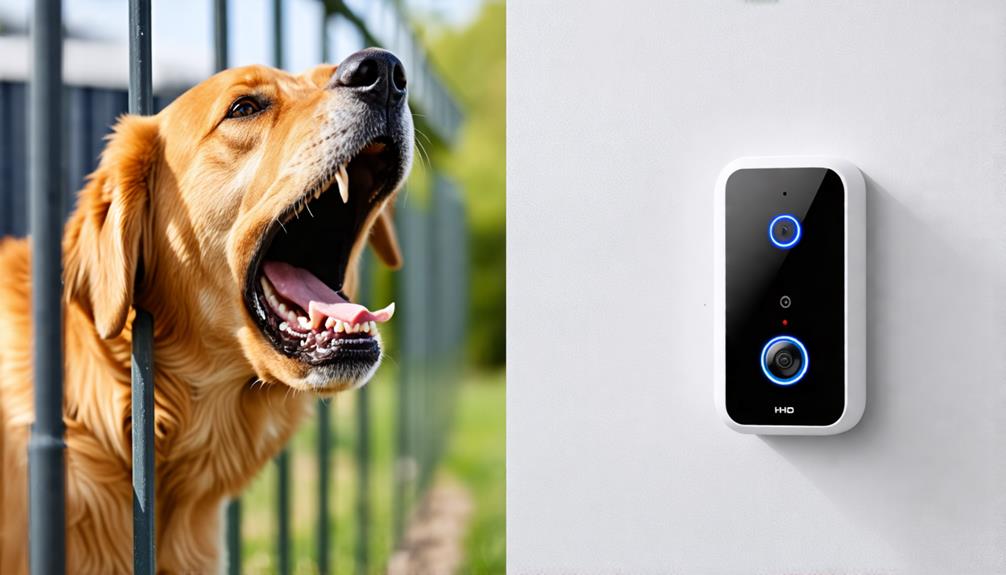
Brainstorm Security Shop

For Orders Over $199

On Any Of Our Products

Details On Refund Page
When you’re evaluating home security options, you might find yourself torn between the innovative barking dog alarm and the more traditional alarm systems. Both have their merits, but which one aligns best with your unique needs? If you’re leaning towards a solution that doesn’t require monthly fees and you value simplicity, a barking dog alarm could be right up your alley. On the other hand, if comprehensive coverage and cutting-edge technology are your priorities, you might prefer a traditional alarm. Let’s explore the key differences that could sway your decision, keeping in mind the implications for both security and budget. What factors will tip the scales for you?
While traditional security systems rely on sensors and alarms, barking dog alarms offer a unique and proactive approach to home security. Unlike conventional methods, these innovative devices employ realistic barking behavior to deter potential intruders.
When you’re considering how to protect your home, it’s vital to understand how these alarms work and why they might be the right choice for you.
Barking dog alarms use advanced technology to mimic the sound of a real dog barking. The sound sensitivity feature is particularly crucial; it triggers the alarm when it detects noise or movement outside your home. This means the alarm doesn’t just react—it proactively scares off anyone who comes too close.
You’ll find that this type of alarm system integrates seamlessly into your daily life. Since there’s no actual dog to care for, you avoid the responsibilities that come with a real pet while still benefiting from the protective illusion of having a dog.
Furthermore, the sound sensitivity can be adjusted, ensuring that the barking is loud enough to be effective but not so loud as to disturb your neighbors or household.
Considering a barking dog alarm could be a smart move if you’re looking for an alternative that keeps intruders at bay with convincing, proactive alerts.
Traditional alarms, among the most reliable security options, provide several key features designed to safeguard your home effectively. They rely on advanced sensor technology and a variety of alarm types to create a robust security system that you can trust.
Here’s a closer look at what makes them stand out:
This layered approach ensures that you’re alerted at the first sign of trouble.
This flexibility lets you tailor the system to your specific security requirements.
This integration enhances your ability to monitor and control your home’s security remotely.
Now that you understand the key features of traditional alarms, let’s examine how they compare to the barking dog alarm in terms of installation.
Traditional alarms often involve a complex setup that includes wiring, mounting sensors, and configuring control panels. This process usually requires professional installation, which can be inconvenient and time-consuming.
On the other hand, the barking dog alarm capitalizes on advancements in wireless technology, making its installation a breeze. You won’t need to drill holes or manage intricate wiring systems. Instead, you simply place the device in a strategic location, turn it on, and it’s ready to work.
This DIY approach not only saves time but also allows you to easily adjust the placement as needed without additional help.
The user experience is significantly enhanced with a barking dog alarm. Its simplicity appeals to those who aren’t tech-savvy and to those who prefer a straightforward, hassle-free setup.
You’re empowered to manage your home security without the need for external support, giving you control and peace of mind with minimal effort.
As you can see, when it comes to installation, the barking dog alarm offers a clear advantage in simplicity and user convenience.
Shifting focus to cost, let’s break down the financial aspects of barking dog alarms compared to traditional systems. When you’re choosing between these two, it’s crucial to consider how each impacts your wallet.
Barking dog alarms capitalize on the sound of a dog barking to deter intruders. This alarm technology simulates the barking behavior of a dog when motion is detected.
Here’s an overview of cost elements you should consider:
In essence, if you’re looking for a cost-effective security solution, a barking dog alarm could be right up your alley.
However, it’s important to weigh these costs against how well each option meets your security needs.

While cost plays a significant role in deciding between a barking dog alarm and a traditional security system, effectiveness in deterring intruders is equally important.
You’ll find that the barking dog alarm can be surprisingly effective. Its main advantage? The barking intensity, which mimics a real dog, can make intruders think twice before entering your property. This perceived presence of a dog can be a strong deterrent, as the sound of barking usually signals to a burglar that they’re about to face a potentially aggressive animal.
However, it’s not just about scaring off would-be intruders. You also need to consider your neighbors. The constant noise, especially if it’s a false alarm, might annoy those living nearby.
Unlike traditional alarms that typically alert silently or directly to a monitoring service, a barking alarm can lead to complaints or even desensitization to the sound, reducing its effectiveness over time.
Ultimately, you’ve got to weigh these factors. If your neighborhood is tightly knit and the sound isn’t a nuisance, a barking dog alarm could serve well.
But if you’re in a quieter, more reserved area, the traditional system might be the way to go, avoiding potential issues with neighbors while keeping your home secure.
Considering maintenance, you’ll find that a barking dog alarm generally requires less upkeep compared to a traditional security system. The simplicity of the barking dog alarm not only enhances user experience but also cuts down on the frequent maintenance checks that are routine with conventional systems.
Here are three key aspects where the barking dog alarm takes the lead in maintenance:
You’ll appreciate how these factors contribute to a more seamless user experience, keeping your home security robust without the added stress of constant upkeep.
When considering the best alarm system for your home, you should think about whether you live in an urban or rural setting.
The size and layout of your home also play crucial roles in deciding whether a barking dog alarm or a traditional alarm is more suitable.
Each option offers different benefits that might better match your living situation.
Choosing between a barking dog alarm and a traditional alarm system might depend heavily on whether you live in an urban or rural setting.
In the bustling city, where urban noise is a constant, the sound of a barking dog alarm might blend in more seamlessly. You’re used to the cacophony of car horns, shouting, and the general din of city life. Here, a barking dog alarm can provide a realistic deterrent without standing out as an anomaly.
In contrast, rural tranquility means that any sound, particularly the abrupt bark of a dog, stands out starkly. This can be a double-edged sword. On one hand, the distinct sound can quickly alert you and your neighbors to potential intruders. On the other, it might be too conspicuous in a setting where noises are sparse.
Here are some key points to consider:

As we explore the impact of your living environment on alarm choice, it’s also important to consider how the size and layout of your home play a role. The right alarm placement and sound range are critical to ensure you’re adequately protected.
In larger homes, you’ll need an alarm system with a broad sound range to cover every corner. Traditional alarms often have comprehensive systems that can be expanded with additional sensors and sirens to fit sprawling layouts. You’ll want to place the main unit and additional sirens strategically to cover all entry points and critical areas.
Conversely, in smaller homes or apartments, a barking dog alarm might be more suitable. These alarms typically have a sound range that’s perfect for compact spaces. They emit loud barks when triggered, which often suffices to cover the limited area without additional components. The placement is simpler too, as one unit is usually enough to monitor the main entrance or hallway.
Choosing between a barking dog alarm and a traditional system depends largely on the size and design of your space. Consider what’s necessary for effective coverage and security, ensuring you’re not left with blind spots or unnecessary overlaps.
Consider your specific needs and environment before deciding between a barking dog alarm and a traditional alarm system. Both options cater to different user preferences and security concerns, so it’s crucial you weigh what’s most important for you and your household.
Here are three key points to guide your decision:
Ultimately, your choice should align with your lifestyle, budget, and the level of security you’re after.
Don’t rush your decision; it’s about finding the right fit for your peace of mind.
You’re wondering if your alarm can sync with smart home systems.
Yes, many barking dog alarms integrate smoothly with smart technology, enhancing user experience. They can connect via Wi-Fi or Bluetooth, allowing you to control them through your smartphone or voice assistant.
This setup not only improves convenience but also lets you customize settings to better fit your lifestyle, ensuring your home’s security is as robust and user-friendly as possible.
Yes, traditional alarms often offer pet-friendly sensors that minimize false triggers caused by your pets’ movements.
These systems typically include pet sensitivity features to distinguish between human and pet activity.
Additionally, many allow alarm customization options, enabling you to adjust sensitivity levels and tailor the system to suit your home’s specific needs, ensuring that you and your pets can move freely without accidentally setting off the alarm.
When you’re comparing warranties, it’s essential to examine the warranty duration and coverage limitations.
Typically, traditional alarms come with longer warranty periods due to their established technology. Barking dog alarms might offer shorter warranties as they’re generally less complex.
Always check for what specific damages or malfunctions are covered under these warranties to ensure you’re adequately protected against potential defects or issues that may arise after installation.
When you’re comparing alarm performance in extreme weather conditions, it’s essential to consider their weather resilience.
Typically, traditional alarms are built to endure harsh conditions, featuring waterproof and temperature-resistant components.
On the other hand, barking dog alarms might struggle, especially if they’re not explicitly designed for outdoor use.
You’d want to check the specifications to ensure they match your climate needs; otherwise, you might face reliability issues when it really counts.
You’ll find rental-specific models available that comply with rental regulations.
Both alarm types offer flexible installation options, making them suitable for temporary setups.
Whether you’re dealing with a lease or temporary housing, these models can adapt to various environments without permanent modifications.
It’s handy for ensuring security in rented spaces, allowing you to choose a system that best fits your temporary living situations without compromising on safety.
You’ve got options when it comes to securing your home. If you’re seeking a budget-friendly, easy setup, a barking dog alarm might be perfect for you. However, if comprehensive monitoring is what you need, a traditional alarm could be worth the extra cost. Consider your specific security needs and living environment before deciding. Remember, whether it’s the simulated bark or sophisticated sensors, the goal is to feel safe and secure in your home.
